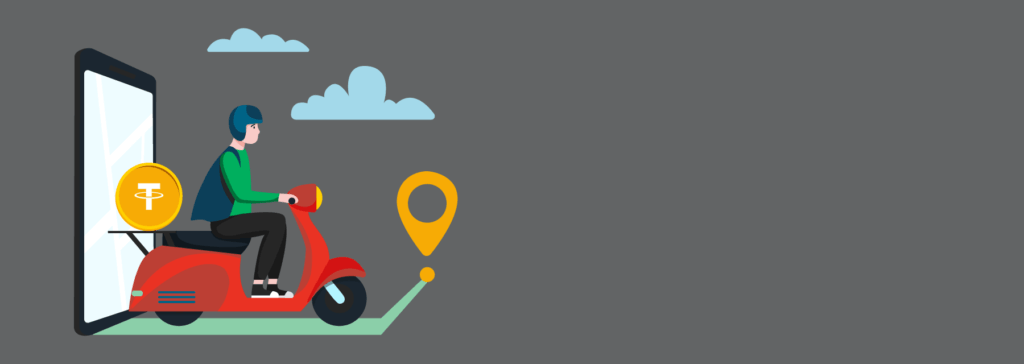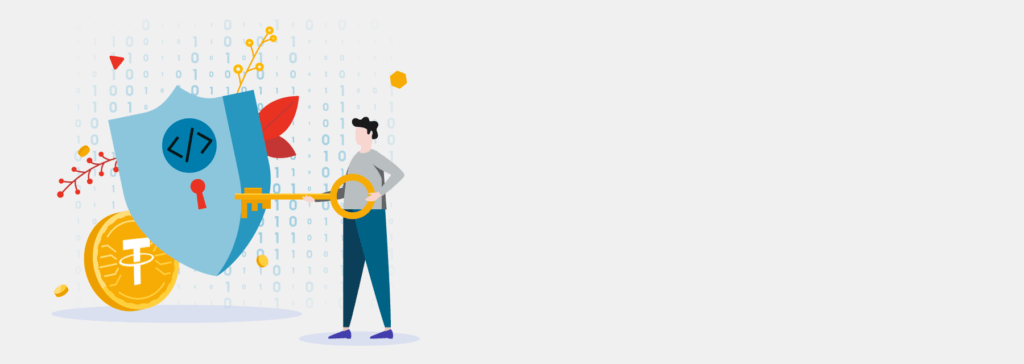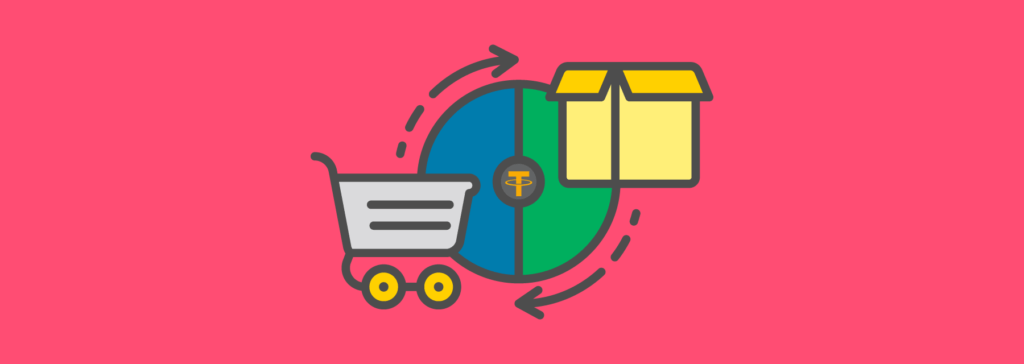
Binance
Only for verified users
Become a master of the Tether world with CryptoMeister.
Beginners and veterans alike can learn more about Tether and how to buy Tether with our handy guide to Tether!

Only for verified users


Tether is the biggest stablecoin by market cap, and it’s made a huge name for itself over the years.
Involved in market manipulation scandals, the birth of stablecoins, and used in just about every crypto traders’ portfolio, Tether is larger than life.
Deciding whether you should buy Tether or not can be a tricky call, so we’re going to run you through this pioneering stablecoin.
Get ready to learn everything about Tether, including the good, bad, and the ugly.
If you’re already a Tether veteran, it never hurts to take a trip down memory lane, refreshing yourself along the way.
For beginners, it’s a wonderful idea to learn about Tether and the incredible journey it’s been on over the years.
Buckle up, this adventure is going to take some twists and turns that you won’t expect!

Tether began life as Realcoin, but eventually rebranded to Tether.
Owned by Bitfinex, Tether was designed to be a stablecoin that was impervious to market movements.
Tether is a stablecoin denominated in US Dollars.
For every single unit of Tether (USDT) there is in circulation, there should be at least $1 locked away in a secure account.
This gives USDT a stable price locked at the value of $1.
The whole purpose of stablecoins is that it’s cheaper to exchange your cryptocurrency into another cryptocurrency than it is to cash out to fiat currencies.
You can then remain in cryptocurrency without being exposed to volatility.
Tether and its USDT tokens currently run on multiple blockchains, meaning that you can pick which Tether you want to use.
However, at the end of the day, all Tether is the same – $1.
Tether is the company behind USDT and it pledges to lock away $1 for every 1 USDT that it prints.
Some stablecoins are audited and make the logs public, so that everyone can view and verify.
But Tether opted to keep this data private, allowing rumors to spread about it printing money out of thin air in order to manipulate crypto markets.
Since the New York Attorney General’s office got involved, Tether appears to have cleaned up its act.
Tether works with the Omni blockchain protocol, running on multiple blockchains in order to secure Tether.
If you’re looking to buy Tether, you’re likely interested in what you can use it for.
So, let’s run you through its slightly underwhelming list of use cases.
Tether’s primary use case is to be used by crypto traders looking to exit a cryptocurrency for a period of time.
The trader will opt to exchange their Bitcoin, Ether, Tron or any other cryptocurrency for Tether.
It’s cheaper to exchange crypto into Tether because it’s also a digital currency, meaning it comes with lower fees than cashing out and going into a true fiat currency.
Then, when the market gets to the trader’s desired levels, they simply sell the USDT for the cryptocurrency of their choice.
Due to the fact that Tether is a stablecoin, meaning its price only varies by a maximum of $0.02 from high to low, it’s a safe asset to hold.
As a result, the US government has approved various stablecoins for use.
This means that you can actually go to stores and businesses and pay using Tether and other stablecoins.
While these businesses are still fairly few and far between, it’s a huge step forwards for digital currencies.
Some central banks see this as such a threat that they’re looking at creating their own stablecoins that they control.
This will likely be the next step for stablecoins, and one that many will welcome, owing to Tether’s sketchy past.
When you buy Tether, you’ll want to get your hands on somewhere safe to store it.
All cryptocurrencies can be stored safely and securely in wallets.

The same goes for Tether.
But, because of how it works, you can use virtually any cryptocurrency wallet.
Tether uses the Omni protocol, which uses Bitcoin blockchain to verify, record and allow people to make swaps on the blockchain without the need for an exchange.
In addition to this, Tether is also found on the Ethereum Tron networks.
This means that you can use an ERC-20 or TRC-20 wallet to receive, store and send Tether.
So, you can opt to use one of the best ERC-20 wallets, which are:
If you’re going to stay in USDT for some time, it’s advisable to move it off the exchange you’re using and into your crypto wallet.
Exchanges get hacked and funds go missing all the time.
While Tether is slightly safer and has a higher recovery rate than most other cryptocurrencies, it’s still not totally safe.
You can opt to use Tether on the Tron network, but the ERC-20 version on the Ethereum network is preferred.
For the average Joe, there’s only one way that you can buy Tether, and that’s through an exchange.
If you’ve got big money and want a more personalized service, you can apply to buy Tether directly with Tether.
However, there’s a lengthy vetting process and some hefty fees involved.
So, unless you’re a multi-millionaire and need the personal service of Tether at your beck and call, an exchange will do.
When you want to buy Tether, simply log in to a cryptocurrency exchange and fund your account.
You can fund your account with just about any cryptocurrency on the planet, as there are thousands of Tether trading pairs.
Some crypto exchanges might not support Tether, instead opting for their own stablecoin.
If you’re unsure as to which exchanges support Tether, you can find out by comparing the best crypto exchanges.
Once you’ve picked an exchange to use and have funded your account, simply navigate to the Tether pair with your currency.
Select how much Tether you wish to buy and place the order.
The transaction is then processed, and your cryptocurrency will be exchanged into Tether.
It really is as easy as that.
If you’re making a transaction with Tether, then the same rules that apply to all crypto transactions will be used.
Pick an ERC-20 or TRC-20 wallet that you want to send the Tether tokens to, and paste in the address.
You can opt to scan a QR code as well if you’re using a mobile phone.
Input the amount of Tether that you wish to send and hit send.
The transaction will then make its way to the blockchain and be credited to the recipient’s wallet shortly.
If you’re in the USA and you’re transacting in Tether with a business, then the QR code that you scan will automatically fill in all the required fields for you.

When you buy Tether, you’ll notice that there are two options available – ERC-20 and TRC-20.
ERC-20 runs on the Ethereum network, while TRC-20 runs on the Tron network.
They’re both the same Tether, but running on different networks.
Being able to use a different network is great as you can pick and choose which you use depending on network congestion.
So, if you’re in a rush to send your Tether transaction and Ethereum has a backlog of transactions, you can use Tether on the Tron network, which is usually a lot less busy.
So, as a result, you can have two types of Tether addresses.
One will be an ERC-20 Tether address, and one will be a TRC-20 address.
You can generate either of these Tether addresses inside an ERC-20 or TRC-20 wallet.
Think of your Tether address as your mailing address.
When you send a Tether transaction, you pop in your address so that the network knows where to send the Tether.
All cryptocurrencies come with some forms of risk involved, but Tether is a bit safer.
This is because when you cash out your Tether into a fiat currency, you’ll be asked to provide some form of KYC or ID documents, if you haven’t done so already.
So, if your Tether gets stolen and you report it as early as possible, exchanges will freeze that Tether and recover it for you.
On the other hand, there’s the trouble that Tether could get itself into.
Tether has long been accused of manipulating the price of Bitcoin.
History shows that when more Tether is minted, the price of Bitcoin tends to move significantly.
In fact, the US Attorney General’s Office (US AG) investigated Tether for this and a whole host of other obscenities.
Tether, Bitfinex and the US AG decided to come to an agreement out of court, opting not to disclose the agreement specifics.
Tether and Bitfinex paid a fine to the tune of $18.5 million and are now bound to properly audit their reserves.
So, if Tether gets up to more naughty business, then there’s a good chance that Tether could get halted or banned in certain jurisdictions.
This would then mean that you cannot use Tether and your Tether would essentially become useless in many areas.
Your only option would be to sell it online through a P2P transaction, presuming anyone would want to take it off your hands in the first place.

The whole debate about whether Tether is legal or not has been raging for quite some time.
You’ll get a different answer depending on who you ask.
Obviously, those closely associated with Tether claim that it is regulated, while the facts suggest that Tether isn’t regulated.
Nonetheless, regulation and legality are two different things.
Let’s look at the regulatory aspect first.
Tether claims to be regulated by Financial Crimes Enforcement Network (FinCEN) in the United States.
However, Tether is in fact only registered with FinCEN.
What this means is that FinCEN has given Tether an account to report any suspicious transactions and log AML/KYC reports.
This is true for hundreds of thousands of businesses in the United States.
To clear things up about whether being FinCEN registered is the same as regulated, FinCEN states on its site:
“The inclusion of a business on the MSB Registrant Search Web page is not a recommendation, certification of legitimacy or endorsement of the business by any government agency.”
What this means is that Tether should not be saying that its registration with FinCEN is a regulatory stamp of approval.
Is that legal?
No.
Is it a crime to be unregulated?
No.
So why does Tether do this?
The reason is really simple – its biggest competitors are actually regulated.
USD Coin, which was launched in a partnership between Circle and Coinbase, is licensed by multiple state financial service departments.
So, in a bid to keep up with the competition, Tether has taken the easy path and is trying to confuse people with two similar words that mean very different things.
Then we come whether Tether is legal or not.
Aside from brazenly telling porkies about being regulated when in fact it’s registered, Tether is mostly legal.
Countries have blanket bans and regulations on cryptocurrencies – that includes Stablecoins.
So, if Bitcoin is banned, then so too are stablecoins.
At the moment, there’s a blanket bank on cryptocurrencies in the following countries:
To add to that, some countries have partial bans on crypto.
Partial bans include things like banking bans or transactional bans.
The following countries have partial bans on cryptocurrency:
There are some ways to get around banking bans, such as use a 3rd party payment processor.
For example, in Canada you can use Interac to buy cryptocurrency.
So, if you’re in a country with a banking ban, have a look around at which payment processors will cover up the transaction so that you can still buy crypto safely.

If you’re worrying whether it’s safe or not to buy Tether, then you should relax a bit.
Tether is far safer than many cryptocurrencies out there, owing to the fact that all eyes are currently on it.
It’s supply and reserves are being closely monitored and scrutinized.
While it’s not licensed or regulated in the same way that other stablecoins are, it’s still fairly safe.
Unless you’re incredibly wealthy, or simply like to throw money away, then your only choice to buy Tether is through a cryptocurrency exchange.
If you pick one of the best cryptocurrency exchanges, then you’ll be as safe as can be.
You can check out the best crypto exchanges here.
Simply deposit a fiat or cryptocurrency to your exchange account and head to the USDT market for the currency you have.
Pop in the amount you wish to buy and execute the trade.
Due to the fact that it’s a stablecoin used by crypto traders to hedge risk, you likely won’t find this on the streets.
This means that you’ll be hard pressed to find someone willing to meet you in order to swap your money to USDT.
There are also no Tether ATMs.
So, if you stick to the big exchanges and you follow all the rules, you’re as safe as can be when buying Tether!
You can also read our guide to the best Crypto Security Tips!
In an age where everything is stored on computers and secured by passwords, everything can be hacked.
When we say everything can be hacked, we really mean it.

Your smart home, your email accounts, your webcam, your mobile phone, your TV – it can all be hacked.
Why?
Because the average person doesn’t understand cybersecurity.
And that’s fine.
But, if you want to protect yourself from being hacked and having your cryptocurrency or personal data stolen, you need to put in a bit of work.
Start out by using unique passwords for every single site, application, and platform.
Ideally these are 12 alphanumeric characters long.
You can use a password manager like LastPass or the blockchain powered My Digi Password to help you generate and secure these passwords.
Secondly, never click on links or download attachments from people you don’t know.
If you follow these two steps, you decrease your chances of getting hacked dramatically.
So, yes, you can get hacked and have your Tether stolen.
But if you follow these two steps, you can dramatically reduce the chances.
Throw in 2-factor authentication by using an app like Authy or Google Authenticator and you’re as safe as can be.
If you want to hedge your exposure to volatility by trading into a USD stablecoin, then you’ll want to buy Tether.
There are currently two ways to buy Tether, but the average person only has access to one.
Buying Tether is easy, but we’re going to hold your hand and walk you through the process.
For the average crypto trader, the only way to get your hands on Tether is by buying it through a cryptocurrency exchange.
You can check out the best cryptocurrency exchanges here, as well as which ones offer Tether pairs.
To buy Tether from a crypto exchange, you need to sign up, or log in, then make a deposit.
There are dozens of Tether trading pairs, so you’re not limited to which currency you deposit.
Once you’ve made a deposit and it has been credited to your account, simply head to the USDT market for your currency.
Once there, click on buy, type in the amount you wish to buy, select market order, and hit confirm.
Excellent, now you too are part of the Tether crowd.
If you plan on staying in Tether for a while, it’s recommended that you remove it from the exchange and put it in your own Tether wallet.
You can learn more about cryptocurrency wallets with our detailed guide to crypto wallets!

If you don’t mind spending a little bit of money to have access to Tether’s personalized service, then you can do so.
This is designed for the 1% that have an incredible fortune and want to buy USDT in bulk.
Crypto exchanges and millionaires use this, but you can too if you really want.
You must head over to the Tether website and sign up using their portal.
There’s a fee of $150 to begin the application process.
If you’re accepted into the program, you’ll be able to buy directly from Tether.
You simply log in, select buy, make a deposit to your account and the Tether will appear in your wallet.
The more monthly volume that you push through Tether, the cheaper it gets.
You will need to go through an intense vetting process before you’re accepted, however.
So, bear this in mind if you opt to buy Tether from Tether directly.
There’s no real advantage to doing this, unless you wish to buy huge volumes of Tether.
Due to the fact that there are so many exchanges that support Tether, you’re spoilt for choice with payment methods.
Every exchange has its own set of supported payment methods, so find one that suits you.
You can find this information and more by checking our detailed exchange and broker reviews.
The fastest way to buy Tether is with your credit or debit card, provided you don’t live in a region with a banking ban.
Simply pop in your card details and make a deposit to your exchange of choice.
This method usually comes with a fee, but it’s the fastest and least hassle.
Card fees range from 0.5% to 5% at some exchanges, so do check this out before diving in.
If you can save on fees, it gives you more money to buy Tether with.
Most exchanges accept cards, so you’re pretty safe opting for this method.
If you don’t mind waiting a bit of time, then you can opt to make a bank transfer, provided you don’t live in a jurisdiction with a banking ban.
Bank transfers to crypto exchanges are free to make, but they can take up to 3 working days in most countries.
So, if you’re not in a rush to buy Tether, then save yourself some money and opt for a bank transfer.
It’s a safe and reliable way to buy Tether, so consider using it when possible.
Finally, you can opt to deposit to an exchange using cryptocurrency.
There will usually be a cryptocurrency deposit fee, but this is by far the most common way of buying Tether.
Tether is used to hedge against volatility, so traders will exchange their crypto to Tether, rather than fiat.
If you opt to deposit cryptocurrency, make sure that you’ve selected the right wallet to deposit to, especially in the case of Bitcoin and Bitcoin cash as the addresses use the same structure.

Tether is a stablecoin, meaning that it’s not volatile at all.
It’s pegged to the value of $1 and rarely moves.
There are some circumstances in which it can be worth slightly less or more, but we’re talking about $0.02 in either direction.
On 15 October 2018 it did fall to $0.88 under exceptional circumstances, but this is a rare event.
If you do capitalize on these small movements in price, then you could, in theory, have to pay taxes on your profits from Tether.
You’d have to make more than the minimum capital gains threshold, which is $1,000 in many countries.
That would take a long time for the average Joe trader to accomplish.
If you do buy Tether and sell Tether, just keep track of the prices you buy and sell at.
If you end up making profit, then report it to the tax authorities alongside the other profits you’ve made in crypto.
However, this is a very unlikely scenario. Read more about Crypto Taxes here.

Tether is a stablecoin and is therefore not a currency you’d invest in to make profit.
It’s used as a hedge against risk or adverse market movement.
That being said, if you’re looking for a stablecoin to move your portfolio into in order to cover against risk, then Tether is a great choice.
It’s one of the original stablecoins and is well known, with virtually all exchanges listing it.
It does have a few drawbacks in that it’s potentially untrustworthy, but at the end of the day, it still works and does its job.
The purpose is to maintain a stable price, and it does that well.
So, if you’re looking for a solid stablecoin, Tether is a great choice.
There are other USD stablecoins out there that are worth looking at, but Tether holds its own pretty well.

Tether was one of the first stablecoins, and as such, it spawned a lot of competition.
There are dozens of stablecoins out there, and some are arguably even better.
But, at the end of the day, all a stablecoin needs to do is remain stable.
It must be backed 100% by the fiat currency that it’s pegged to.
Tether has faltered from this core value several times and been called out for it.
So, for that reason, Tether has a bit of a bad reputation.
But following a lawsuit, it appears to have cleaned up its act.
USD Coin is a powerful contender, and it’s even regulated by several state financial service authorities.
This gives you more protection and peace of mind as an investor.
But that doesn’t mean Tether is going to scam you or run off with your money.
If you care about regulation certificates, then you might want to look at USD Coin.
But chances are, the other cryptocurrencies in your portfolio don’t have that certificate either.
You have to draw the line of trust somewhere, so why not start with your stablecoins as you’ve got more choice!

Unlike cryptocurrencies in general, stablecoins like Tether don’t face any supply or demand issues.
Whenever more people want to buy Tether, Tether simply prints more.
If people want to sell Tether, then Tether burns tokens.
The supply cap of Tether is constantly changing.
And while a massive selloff of Tether can cause the price to drop, it takes a crazy amount of money to do so – we’re talking billions of dollars.
Like all currencies on the planet, Tether has a pile of challenges that it must face in the coming years.
But, if it makes the necessary changes to its business model, it can overcome them and succeed.
While tether claims to be fully regulated, it’s not at all.
As time goes on, Tether will be required to apply for a regulatory license.
This would mean that it must clean up its act and actually hold the correct amount of money in reserves.
Laws and regulations will help improve Tether, if it can learn to abide by them.
If not, they could kill Tether off once and for all.
Tether is already registered with FinCEN, meaning that it does the bare minimum with regards to reporting.
In the long-run, it will have to take this process to the next level and join more controlling bodies.
This will be good for Tether as it will restore confidence in its brand.
There are hundreds of stablecoins out there, covering a range of fiat currencies.
On the USD scene, USD Coin is arguably Tether’s biggest competitor.
USD Coin is regulated by several state financial regulatory bodies, which is more than Tether.
It also has a far better reputation as well.
If Tether doesn’t get its act together, it could fall behind USD Coin very easily.
Tether is a huge stablecoin, and it has changed the crypto trading world for the better.
Traders can mitigate risk and hedge against volatility thanks to Tether and the slew of other stablecoins that it has spawned.
However, some poor choices have damaged Tether’s reputation significantly.
If it’s to regain its image of being the best around, it needs to clean up its act and prove that it’s learned its lesson.
If it can do that, Tether will reign as the supreme USD stablecoin for years to come.

Tether has a pretty sketchy past, with it being accused of manipulating Bitcoin back in 2017.
After a lawsuit in the USA, Tether has vowed to clean up its act. So no, Tether is not a scam.
It’s highly unlikely that Tether will crash, but stranger things have happened.
If Tether gets involved in another reserve quantity scandal or accused of manipulating prices of cryptocurrencies once more, we could see it collapse.
If these rumors emerge with significant proof, we could see a major selloff just as we saw in October 2018.